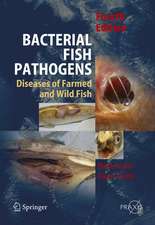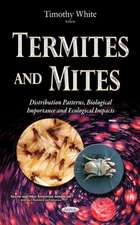Multicellular Animals: A new Approach to the Phylogenetic Order in Nature Volume 1
Autor Peter Axen Limba Engleză Paperback – 7 dec 2011
| Toate formatele și edițiile | Preț | Express |
|---|---|---|
| Paperback (3) | 564.41 lei 38-44 zile | |
| Springer Berlin, Heidelberg – 7 dec 2011 | 564.41 lei 38-44 zile | |
| Springer Berlin, Heidelberg – 29 noi 2010 | 946.24 lei 43-57 zile | |
| Springer Berlin, Heidelberg – 30 noi 2010 | 1222.80 lei 43-57 zile | |
| Hardback (2) | 952.26 lei 43-57 zile | |
| Springer Berlin, Heidelberg – 7 apr 2003 | 952.26 lei 43-57 zile | |
| Springer Berlin, Heidelberg – 27 aug 2000 | 1227.21 lei 43-57 zile |
Preț: 564.41 lei
Preț vechi: 705.51 lei
-20% Nou
Puncte Express: 847
Preț estimativ în valută:
108.03€ • 117.39$ • 90.81£
108.03€ • 117.39$ • 90.81£
Carte tipărită la comandă
Livrare economică 16-22 aprilie
Preluare comenzi: 021 569.72.76
Specificații
ISBN-13: 9783642801167
ISBN-10: 3642801161
Pagini: 232
Ilustrații: 225 p. 68 illus., 1 illus. in color.
Dimensiuni: 193 x 270 x 12 mm
Greutate: 0 kg
Ediția:Softcover reprint of the original 1st ed. 1996
Editura: Springer Berlin, Heidelberg
Colecția Springer
Locul publicării:Berlin, Heidelberg, Germany
ISBN-10: 3642801161
Pagini: 232
Ilustrații: 225 p. 68 illus., 1 illus. in color.
Dimensiuni: 193 x 270 x 12 mm
Greutate: 0 kg
Ediția:Softcover reprint of the original 1st ed. 1996
Editura: Springer Berlin, Heidelberg
Colecția Springer
Locul publicării:Berlin, Heidelberg, Germany
Public țintă
ResearchDescriere
No one can ever have secure knowledge about the gods and creatures, and should anyone hit by chance upon the right thing, he will not know it for sure; that is why everything that we believe to be true is "opinion". XENOPHANES around 500 B.C. (According to ROD 1988, p.85) The goal of phylogenetic systematics (cladistics) is to discover the kinship relations between all organisms on earth and to translate the order we perceive in Nature into an equivalent man-made system. Although the goal is easily formulated, the path is thorny, and the results achieved continue to be imperfect. This is the fate of any science that bases its propositions on the interpretation of histor ical evidence. The diversity found in the millions of species originated as a result of the continuous splitting of biopopulations through time. Combined with this was the emergence of hierarchically linked des cent communities of species. We call the process of origin of descent communities phylogenesis. We do not know, however, the exact course of phylogenesis - we can only formulate hypotheses. The historical evidence at hand consists of the feature patterns of extant species and of extinct species with their combination of original and derived traits which are the result of evolution.
Cuprins
Organisms of the Real World and Their Arrangement in a System Created by Man.- Hypothetical Realism.- Levels of Observation.- Thing and Class.- Individuals and Populations as Things.- Species and Descent Communities as Natural Kinds (Classes).- Natural Kinds as Taxa of the Phylogenetic System.- Elimination of Categories.- Establishing the Phylogenetic System.- Feature Patterns of Species and Ground Patterns of Descent Communities.- The Three Possibilities of Evolutionary Congruences.- Sister Species — Sister Group — Dichotomy.- Lineage — Stem Lineage.- The Formation of Species Groups.- The Change of Meaning Synapomorphy — Symplesiomorphy.- Forming Hypotheses About Synapomorphy.- Homology.- The Search for the Sister Species or Sister Group and the Resulting System.- Hierarchical Tabulation.- Relationship Diagram.- Direct Access to the Autapomorphy.- Molecules and Computers.- The Integration and Meaning of the Fossil Record.- Problematic Large Divisions of Organisms.- ”Animalia“ — ”Plantae“.- ”Procaryota“ — Eucaryota.- ”Protozoa“ — Metazoa.- ”Invertebrata“ — Vertebrata.- The Inflation of Kingdoms.- Systematization of the Metazoa.- Overview.- Monophyly and Ground Pattern.- The Search for the Adelphotaxon Among Unicellular Organisms.- Mesozoa — Parasitic Metazoa with Undetermined Kinship.- Orthonectida.- Dicyemida.- Porifera — Epitheliozoa.- Porifera.- Ground Pattern.- Systematization.- Calcarea — Silicea.- Calcarea.- Silicea.- Demospongea — Hexactinellida.- Demospongea.- Hexactinellida.- Epitheliozoa.- Placozoa — Eumetazoa.- Placozoa.- Eumetazoa.- Cnidaria — Acrosomata.- Cnidaria.- Ground Pattern.- Systematization.- Anthozoa — Tesserazoa.- Anthozoa.- Tesserazoa.- Hydrozoa — Rhopaliophora.- Hydrozoa.- Rhopaliophora.- Cubozoa — Scyphozoa.- Cubozoa.- Scyphozoa.- Acrosomata.- Ctenophora — Bilateria.- Ctenophora.- Ground Pattern.- Bilateria.- Ground Pattern.- Systematization.- Spiralia — Radialia.- Spiralia.- Plathelminthomorpha — Euspiralia.- Plathelminthomorpha.- Gnathostomulida — Plathelminthes.- Gnathostomulida.- Ground Pattern.- Plathelminthes.- Ground Pattern.- Systematization.- Catenulida — Euplathelminthes.- Catenulida.- Euplathelminthes.- Acoelomorpha — Rhabditophora.- Acoelomorpha.- Nemertodermatida — Acoela.- Nemertodermatida.- Acoela.- Rhabditophora.- Macrostomida — Trepaxonemata.- Macrostomida.- Trepaxonemata.- Polycladida — Neoophora.- Polycladida.- Neoophora.- Lecithoepitheliata.- Prolecithophora.- Seriata — Rhabdocoela.- Seriata.- Rhabdocoela.- ”Typhloplanoida“ — Doliopharyngiophora.- ”Typhloplanoida“.- Doliopharyngiophora.- ”Dalyellioida“ — Neodermata.- ”Dalyellioida“.- Neodermata.- Trematoda — Cercomeromorpha.- Trematoda.- Aspidobothrea — Digenea.- Aspidobothrea.- Digenea.- Cercomeromorpha.- Monogenea — Cestoda.- Monogenea.- Cestoda.- Xenoturbellida — A Eumetazoan Taxon with Unclarified Kinship.- Euspiralia.- Nemertini — Trochozoa.- Nemertini.- Traditional Classification.- Ground Pattern and Evolutionary Alterations.- Trochozoa.- Literature.- Register.
Caracteristici
The second volume of Professor Ax' revised systematics of all multicellular animals.
Includes supplementary material: sn.pub/extras
Includes supplementary material: sn.pub/extras
Textul de pe ultima copertă
The system of multicellular animals presented here is an alternative to the traditional classification which still operates with the categories of Carl v. Linné, including typological divisions in artificial species groups. In a new approach to the phylogenetic order in nature this book strives for an objective systematization of the Metazoa. It seeks a new path in the field of academic research and teaching based on the theory and methodology of phylogenetic systematics. This volume covers the Metazoa from the Mollusca up to the Arthropoda; the last volume III will treat the Nemathelminthes and the Deuterostomia.











